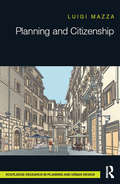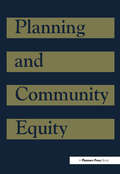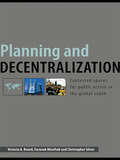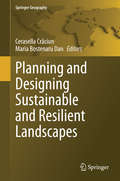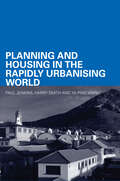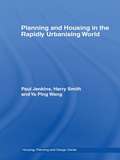- Table View
- List View
Planning and Budgeting Skills for Health and Social Work Managers
by Richard FieldAt a time of increasing government austerity, it is vital that managers and leaders within health and social care organisations have a critical understanding of good planning and budgeting skills. This handbook will guide managers through the complex area of the planning process and includes sections on organisational aspects of planning, completing evaluation forms and analysis and strategic goal-setting. The Author then looks at effective budgeting skills including year-end forecasting, profiling and efficiency.
Planning and Citizenship
by Luigi MazzaPlanning is undergoing a period of profound change and risks losing meaning and authority by becoming merely a tool for financial speculation and generating capital. Planning and Citizenship seeks to rediscover planning’s technical and theoretical roots by reconstructing the memory of planning through the lens of the changing relationship between planning and citizenship. Tracing the historical relationship between planning and citizenship through a single thread, Luigi Mazza employs three ancient models – those of Hippodamus, Romulus, and Ancient China – to understand the foundations of spatial governance and citizenship. Paying particular attention to classic case studies of American cities, this book moves through the development of central planning theories by key thinkers like Geddes, Cerdà, Howard, Abercrombie and Lefebre. Analysing the role of government in promoting social citizenship and symbolic values through planning, Mazza takes into account the changing role of government in planning, including concepts of neoliberalism and the minimal State. Providing critical debate over the current role of spatial governance in planning and citizenship, Planning and Citizenship offers a unique historical analysis of a crucial topic in planning.
Planning and Citizenship
by Luigi MazzaPlanning is undergoing a period of profound change and risks losing meaning and authority by becoming merely a tool for financial speculation and generating capital. Planning and Citizenship seeks to rediscover planning’s technical and theoretical roots by reconstructing the memory of planning through the lens of the changing relationship between planning and citizenship. Tracing the historical relationship between planning and citizenship through a single thread, Luigi Mazza employs three ancient models – those of Hippodamus, Romulus, and Ancient China – to understand the foundations of spatial governance and citizenship. Paying particular attention to classic case studies of American cities, this book moves through the development of central planning theories by key thinkers like Geddes, Cerdà, Howard, Abercrombie and Lefebre. Analysing the role of government in promoting social citizenship and symbolic values through planning, Mazza takes into account the changing role of government in planning, including concepts of neoliberalism and the minimal State. Providing critical debate over the current role of spatial governance in planning and citizenship, Planning and Citizenship offers a unique historical analysis of a crucial topic in planning.
Planning and Community Equity: A Component of APA's Agenda for America's Communities
by American Institute of Certified PlannersThis thought-provoking book exhorts planners to establish community development programs that achieve greater social and economic equity. Some of the 13 chapters urge planners to incorporate community equity concerns into traditional planning areas such as transportation and economic development. Others challenge planners to get more involved in social areas such as urban education and community policing. Each chapter is authored by one or more professionals with expertise in the subject at hand. A helpful resource for planners who continue to tackle the problems of inequality.
Planning and Community Equity: A Component of APA's Agenda for America's Communities
by American Institute of Certified PlannersThis thought-provoking book exhorts planners to establish community development programs that achieve greater social and economic equity. Some of the 13 chapters urge planners to incorporate community equity concerns into traditional planning areas such as transportation and economic development. Others challenge planners to get more involved in social areas such as urban education and community policing. Each chapter is authored by one or more professionals with expertise in the subject at hand. A helpful resource for planners who continue to tackle the problems of inequality.
Planning and Conflict: Critical Perspectives on Contentious Urban Developments (RTPI Library Series)
by Enrico GualiniPlanning and Conflict discusses the reasons for conflicts around urban developments and analyzes their shape in contemporary cities. It offers an interdisciplinary framework for scholars to engage with the issue of planning conflicts, focusing on both empirical and theoretical inquiry. By reviewing different perspectives for planners to engage with conflicts, and not simply mediate or avoid them, Planning and Conflict provides a theoretically informed look forward to the future of engaged, responsive city development that involves all its stakeholders.
Planning and Conflict: Critical Perspectives on Contentious Urban Developments (RTPI Library Series)
by Enrico GualiniPlanning and Conflict discusses the reasons for conflicts around urban developments and analyzes their shape in contemporary cities. It offers an interdisciplinary framework for scholars to engage with the issue of planning conflicts, focusing on both empirical and theoretical inquiry. By reviewing different perspectives for planners to engage with conflicts, and not simply mediate or avoid them, Planning and Conflict provides a theoretically informed look forward to the future of engaged, responsive city development that involves all its stakeholders.
Planning and Decentralization: Contested Spaces for Public Action in the Global South
by Victoria A. Beard Faranak Miraftab Christopher SilverThe first in-depth study of the impact of economic and political decentralization on planning practice in developing economies, this innovative volume, using original case study research by leading experts drawn from diverse fields of inquiry, from planning to urban studies, geography and economics, explores the dramatic transformation that decentralization implies in responsibilities of the local planning and governance structures. It examines a range of key issues, including: public and private finance local leadership and electoral issues planning in post-conflict societies. Offering unique insights into how planning has changed in specific countries, paying particular attention to South East Asian economies, India and South Africa, this excellent volume is an invaluable resource for researchers, graduate students and planners interested in urban planning in its international political and economic context.
Planning and Decentralization: Contested Spaces for Public Action in the Global South
by Faranak Miraftab Christopher Silver Victoria A BeardThe first in-depth study of the impact of economic and political decentralization on planning practice in developing economies, this innovative volume, using original case study research by leading experts drawn from diverse fields of inquiry, from planning to urban studies, geography and economics, explores the dramatic transformation that decentralization implies in responsibilities of the local planning and governance structures. It examines a range of key issues, including: public and private finance local leadership and electoral issues planning in post-conflict societies. Offering unique insights into how planning has changed in specific countries, paying particular attention to South East Asian economies, India and South Africa, this excellent volume is an invaluable resource for researchers, graduate students and planners interested in urban planning in its international political and economic context.
Planning and Design for Future Informal Settlements: Shaping the Self-Constructed City
by David GouverneurThis is the first book to address future informal settlements at the global scale. It argues that to foster favourable conditions for the sustainable evolution of future informal cities, planners must consider the same issues that are paramount in formal urban developments, such as provision of: balanced land uses energy efficiency and mobility water management and food sufficiency governance and community participation productivity and competitiveness identity and sense of place Planning and Design for Future Informal Settlements makes a call for responsible action to address the urban challenges of the developing world, suggesting that the vitality of informality, coupled with spatial design and good management, can support the efficient use of resources in better places to live. The book analyses the strengths and weaknesses of informal urbanism and the challenges faced by the fast growing cities of the developing world. Through case studies, it demonstrates the contributions and limitations of different attempts to plan ahead for urban growth, from the creation of formal housing and urban infrastructures for self-built dwellings to the improvement of existing informal settlements. It provides a robust framework for planners and designers, policy-makers, NGOs and local governments working to improve living conditions in developing cities.
Planning and Design for Future Informal Settlements: Shaping the Self-Constructed City
by David GouverneurThis is the first book to address future informal settlements at the global scale. It argues that to foster favourable conditions for the sustainable evolution of future informal cities, planners must consider the same issues that are paramount in formal urban developments, such as provision of: balanced land uses energy efficiency and mobility water management and food sufficiency governance and community participation productivity and competitiveness identity and sense of place Planning and Design for Future Informal Settlements makes a call for responsible action to address the urban challenges of the developing world, suggesting that the vitality of informality, coupled with spatial design and good management, can support the efficient use of resources in better places to live. The book analyses the strengths and weaknesses of informal urbanism and the challenges faced by the fast growing cities of the developing world. Through case studies, it demonstrates the contributions and limitations of different attempts to plan ahead for urban growth, from the creation of formal housing and urban infrastructures for self-built dwellings to the improvement of existing informal settlements. It provides a robust framework for planners and designers, policy-makers, NGOs and local governments working to improve living conditions in developing cities.
Planning and Design for Sustainable Urban Mobility: Global Report on Human Settlements 2013
by Un-HabitatUrban transport systems worldwide are faced by a multitude of challenges. Among the most visible of these are the traffic gridlocks experienced on city roads and highways all over the world. The prescribed solution to transport problems in most cities has thus been to build more infrastructures for cars, with a limited number of cities improving public transport systems in a sustainable manner. However, a number of challenges faced by urban transport systems – such as greenhouse gas emissions, noise and air pollution and road traffic accidents – do not necessarily get solved by the construction of new infrastructure. Planning and Design for Sustainable Urban Mobility argues that the development of sustainable urban transport systems requires a conceptual leap. The purpose of ‘transportation’ and ‘mobility’ is to gain access to destinations, activities, services and goods. Thus, access is the ultimate objective of transportation. As a result, urban planning and design should focus on how to bring people and places together, by creating cities that focus on accessibility, rather than simply increasing the length of urban transport infrastructure or increasing the movement of people or goods. Urban form and the functionality of the city are therefore a major focus of this report, which highlights the importance of integrated land-use and transport planning. This new report of the United Nations Human Settlements Programme (UN-Habitat), the world’s leading authority on urban issues, provides some thought-provoking insights and policy recommendations on how to plan and design sustainable urban mobility systems. The Global Report on Human Settlements is the most authoritative and up-to-date global assessment of human settlements conditions and trends. Preceding issues of the report have addressed such topics as Cities in a Globalizing World, The Challenge of Slums, Financing Urban Shelter, Enhancing Urban Safety and Security, Planning Sustainable Cities and Cities and Climate Change.
Planning and Design for Sustainable Urban Mobility: Global Report on Human Settlements 2013
by Un-HabitatUrban transport systems worldwide are faced by a multitude of challenges. Among the most visible of these are the traffic gridlocks experienced on city roads and highways all over the world. The prescribed solution to transport problems in most cities has thus been to build more infrastructures for cars, with a limited number of cities improving public transport systems in a sustainable manner. However, a number of challenges faced by urban transport systems – such as greenhouse gas emissions, noise and air pollution and road traffic accidents – do not necessarily get solved by the construction of new infrastructure. Planning and Design for Sustainable Urban Mobility argues that the development of sustainable urban transport systems requires a conceptual leap. The purpose of ‘transportation’ and ‘mobility’ is to gain access to destinations, activities, services and goods. Thus, access is the ultimate objective of transportation. As a result, urban planning and design should focus on how to bring people and places together, by creating cities that focus on accessibility, rather than simply increasing the length of urban transport infrastructure or increasing the movement of people or goods. Urban form and the functionality of the city are therefore a major focus of this report, which highlights the importance of integrated land-use and transport planning. This new report of the United Nations Human Settlements Programme (UN-Habitat), the world’s leading authority on urban issues, provides some thought-provoking insights and policy recommendations on how to plan and design sustainable urban mobility systems. The Global Report on Human Settlements is the most authoritative and up-to-date global assessment of human settlements conditions and trends. Preceding issues of the report have addressed such topics as Cities in a Globalizing World, The Challenge of Slums, Financing Urban Shelter, Enhancing Urban Safety and Security, Planning Sustainable Cities and Cities and Climate Change.
Planning and Design Perspectives for Land Take Containment: An Operative Framework (SpringerBriefs in Geography)
by Benedetta GiudiceThis book aims to provide a framework for the concept of land take, the practice by which natural lands are lost to artificial land development practices, and present its ecological implications in urban environments. In particular, the book intends to contextualize land take and its ecological implications in the field of planning through the analysis of the evolution of the relationship that exists between ecology and urban and regional planning, with case studies focusing on cities in Europe. Urban and regional planning (specifically in terms of tools, policies and strategies) play a central role in the redevelopment of this relationship, and through this perspective the text explores some operational criteria and guiding strategies for the creation of innovative scenarios of planning and design. The book is indeed mainly based upon an ecological planning-oriented perspective, with the attempt of creating a strong link between the plan and the project that will be useful for students, researchers, policy makers, and urban planners and designers.
Planning and Designing Sustainable and Resilient Landscapes (Springer Geography)
by Cerasella Crăciun Maria Bostenaru DanThis book deals with planning issues in landscape architecture, which start at the evaluation of the existing fabric of society, its history and memory, approached and conserved through photography, film and scenographic installations, a way in which the archetypes can be investigated, be it industrial derelict sites or already green spaces and cultural landscapes. It provides approaches to intervention, through rehabilitation and upgrade, eventually in participative manner. To such evaluation and promotion a couple of disciplines can contribute such as history of art, geography and communication science and of course (landscape) architecture. The field of landscape architecture reunites points of view from such different disciplines with a view to an active approach a contemporary intervention or conservation. The book presents case studies from several European countries (Romania, Germany, Austria, Italy, Portugal) mostly for large landscape in the outskirts of the cities and in the parks.
Planning and Designing the Absent City: Campsites as Temporary Settlements
by Luca TrabattoniThis book concerns the study of open-air accommodation facilities. The market evolutions allow us to look at these structures as temporary settlements characterised by a low-density dwelling and a close connection with natural elements and the landscape.This new and different point of view is sustained by the tendency of outdoor tourism to go in the direction of temporary villages, and this tendency is directly related to "time" and "landscape". The landscape is the reason why the campsite is settled. The time is linked to the holiday season timing. Today, both are greatly influenced by the introduction of the "Maxi-Caravan". This removable living unit can be placed on the empty pitch, occupying the landscape without ruining the soil. By the settlement of Maxi-Caravans, the campsite is transformed from an empty landscape with tents to a temporary settlement, whose timing is divided between the seasonal timing of the campsite and the "timing" of the product, and whose landscape is organised by the relation with the prevalent landscape and the internal one. The book's core defines the outdoor facility structure, using Italy as the main case study. To identify design strategies, the book analyses temporary settlement examples (quick time) and projects from historic outdoor tourism (medium time). Finally, the last chapter reflects on open-air accommodation facilities by showing their applicability in the different contexts of the refugee camps (long time).The aim of this research is to enhance the theme of open-air accommodation facilities, highlighting the need to equalise the study of temporary settlements with that of permanent settlements. It will be of interest to researchers and students of planning, landscape and tourism.
Planning and Designing the Absent City: Campsites as Temporary Settlements
by Luca TrabattoniThis book concerns the study of open-air accommodation facilities. The market evolutions allow us to look at these structures as temporary settlements characterised by a low-density dwelling and a close connection with natural elements and the landscape.This new and different point of view is sustained by the tendency of outdoor tourism to go in the direction of temporary villages, and this tendency is directly related to "time" and "landscape". The landscape is the reason why the campsite is settled. The time is linked to the holiday season timing. Today, both are greatly influenced by the introduction of the "Maxi-Caravan". This removable living unit can be placed on the empty pitch, occupying the landscape without ruining the soil. By the settlement of Maxi-Caravans, the campsite is transformed from an empty landscape with tents to a temporary settlement, whose timing is divided between the seasonal timing of the campsite and the "timing" of the product, and whose landscape is organised by the relation with the prevalent landscape and the internal one. The book's core defines the outdoor facility structure, using Italy as the main case study. To identify design strategies, the book analyses temporary settlement examples (quick time) and projects from historic outdoor tourism (medium time). Finally, the last chapter reflects on open-air accommodation facilities by showing their applicability in the different contexts of the refugee camps (long time).The aim of this research is to enhance the theme of open-air accommodation facilities, highlighting the need to equalise the study of temporary settlements with that of permanent settlements. It will be of interest to researchers and students of planning, landscape and tourism.
Planning and Diversity in the City: Redistribution, Recognition and Encounter (Planning, Environment, Cities)
by Kurt Iveson Ruth FincherPlanning theory and practice has become more conscious in recent times of the need to cater for a diverse range of needs and preferences. But there has been less clarity about what goals and objectives should inform planning for such diversity. In this important new book Ruth Fincher and Kurt Iveson identify three distinct working principles of planning for diversity: redistribution, recognition and encounter. Each principle is the subject of a pair of chapters. The first explaining the principle and the second showcasing and comparing efforts to shape cities according to it, drawing on relevant examples from around the world.Planning for Diversity is the ideal introduction to the issues that surround diversity and planning and provides a stimulating new line of advance for reducing inequality and working towards 'just diversity' in cities.RUTH FINCHER is Professor of Geography at the University of Melbourne, AustraliaKURT IVESON is Lecturer in Urban Geography at the University of Sydney, Australia
Planning and Ecology
by R. D. Roberts T. M. RobertsProfessional planning is commonly defined as an activity which is concerned with the rational allocation or exploitation of resources for man's maximum short- and long-term benefit. The science of. ecology is the study of the basic components of these resources (soil, water, air etc. ) and their inter relationships with living organisms. Planning and ecology therefore have many common interests and, as such, have long been associated in resource management. This association was, for example, reflected as early as the 19th century in the writings of Patrick Geddes, the progenitor of modern town planning, whose training as a biologist led him to re-interpret the phenomena of urbanization in ecological terms (Geddes, 1886). Since the time of Geddes the place of ecology has declined in planning circles as other professions and considerations, initially public health and engineering, latterly economic and sociological, have become more central. The reasons for this shifting emphasis are three-fold. First, they reflect changing social attitudes and aspirations in the post-war period. Secondly, many other professions and persuasions (agriculturalists, foresters, in dustrialists etc. ) became organized as pressure groups and helped shape public attitudes and governmental actions. Thirdly, and by far the most important reason, is the prevalence of misconceptions about ecology. Too many people, perhaps misled by the debate surrounding the' environmental movement', equate ecology with conservation. In reality, conservation is but one component part of ecology.
Planning and Evaluation for Public Safety Leaders: A Toolkit
by Shane NordykePlanning and Evaluation for Public Safety Leaders presents field-tested techniques and tips to help public safety leaders effectively manage their organizations and overcome challenges. Organizations and agencies operating within the public safety sector are unique in many respects. These unique elements provide a different context in which planning, and performance measurement occur. Without recognizing this particular context, most public planning texts ignore crucial pieces of the puzzle when it comes to effectively achieving and measuring public safety outcomes. This book’s practical approach equips students with approachable explanations specific to the public safety context, and practical tools for public safety leaders that can apply to their organizations. Key Features • Each chapter begins with a real-world case from the public safety sector that highlights the importance or possible application of the information covered. • Cases are written in close coordination with the public safety practitioners to illustrate how the concepts covered in the chapter work in a real-world public safety context. • "Put it into Practice" Reflections at the end of each chapter allow new or future public safety leaders to apply the material directly to their current organization. • Boxes describe how to use and apply specific methods in a concise and easy to find tools addressing planning and evaluation challenges as they arise • Key terms and application questions written specifically for students, focus in on the most important concepts and terms from the text. • Overviews of relevant theoretical and scholarly work on the concepts offer connections with course material.
Planning and Evaluation for Public Safety Leaders: A Toolkit
by Shane NordykePlanning and Evaluation for Public Safety Leaders presents field-tested techniques and tips to help public safety leaders effectively manage their organizations and overcome challenges. Organizations and agencies operating within the public safety sector are unique in many respects. These unique elements provide a different context in which planning, and performance measurement occur. Without recognizing this particular context, most public planning texts ignore crucial pieces of the puzzle when it comes to effectively achieving and measuring public safety outcomes. This book’s practical approach equips students with approachable explanations specific to the public safety context, and practical tools for public safety leaders that can apply to their organizations. Key Features • Each chapter begins with a real-world case from the public safety sector that highlights the importance or possible application of the information covered. • Cases are written in close coordination with the public safety practitioners to illustrate how the concepts covered in the chapter work in a real-world public safety context. • "Put it into Practice" Reflections at the end of each chapter allow new or future public safety leaders to apply the material directly to their current organization. • Boxes describe how to use and apply specific methods in a concise and easy to find tools addressing planning and evaluation challenges as they arise • Key terms and application questions written specifically for students, focus in on the most important concepts and terms from the text. • Overviews of relevant theoretical and scholarly work on the concepts offer connections with course material.
Planning and Housing in the Rapidly Urbanising World (Housing, Planning and Design Series)
by Paul Jenkins Harry Smith Ya Ping WangWritten specifically as a teaching text and authored by a team of leading academics in the field, this is the first book to bring together the key issues of rapid urbanisation with approaches to planning and housing. Outlining and explaining core concepts from ‘informal settlements’ to ‘sustainability’, it focuses on the rapid urbanization of developing countries with case studies from Latin America, Asia and Sub-Saharan Africa. The impact of rapid urbanization and associated globalization on land-use and housing is described and analyzed with reference to the particular issues of poverty, health and the environment of these areas. Providing an accessible introduction to the key issues as well as enhancing current theoretical debates and exploring practical applications, this book is an essential resource for students and researchers in this area.
Planning and Housing in the Rapidly Urbanising World (Housing, Planning and Design Series)
by Paul Jenkins Harry Smith Ya Ping WangWritten specifically as a teaching text and authored by a team of leading academics in the field, this is the first book to bring together the key issues of rapid urbanisation with approaches to planning and housing. Outlining and explaining core concepts from ‘informal settlements’ to ‘sustainability’, it focuses on the rapid urbanization of developing countries with case studies from Latin America, Asia and Sub-Saharan Africa. The impact of rapid urbanization and associated globalization on land-use and housing is described and analyzed with reference to the particular issues of poverty, health and the environment of these areas. Providing an accessible introduction to the key issues as well as enhancing current theoretical debates and exploring practical applications, this book is an essential resource for students and researchers in this area.
Planning and knowledge: How new forms of technocracy are shaping contemporary cities
by Mike Raco Federico SaviniThis book uses an international perspective and draws on a wide range of new conceptual and empirical material to examine the sources of conflict and cooperation within the different landscapes of knowledge that are driving contemporary urban change. Based on the premise that historically-established systems of regulation and control are being subject to unprecedented pressures, scholars critically reflect on the changing role of planning and governance in sustainable urban development, looking at how a shift in power relations between expert and local cultures in western planning processes has blurred the traditional boundaries between public, private, and voluntary sectors.
Planning and knowledge: How new forms of technocracy are shaping contemporary cities
This book uses an international perspective and draws on a wide range of new conceptual and empirical material to examine the sources of conflict and cooperation within the different landscapes of knowledge that are driving contemporary urban change. Based on the premise that historically-established systems of regulation and control are being subject to unprecedented pressures, scholars critically reflect on the changing role of planning and governance in sustainable urban development, looking at how a shift in power relations between expert and local cultures in western planning processes has blurred the traditional boundaries between public, private, and voluntary sectors.

